oil change PONTIAC BONNEVILLE 1997 Owners Manual
[x] Cancel search | Manufacturer: PONTIAC, Model Year: 1997, Model line: BONNEVILLE, Model: PONTIAC BONNEVILLE 1997Pages: 405, PDF Size: 18.83 MB
Page 268 of 405
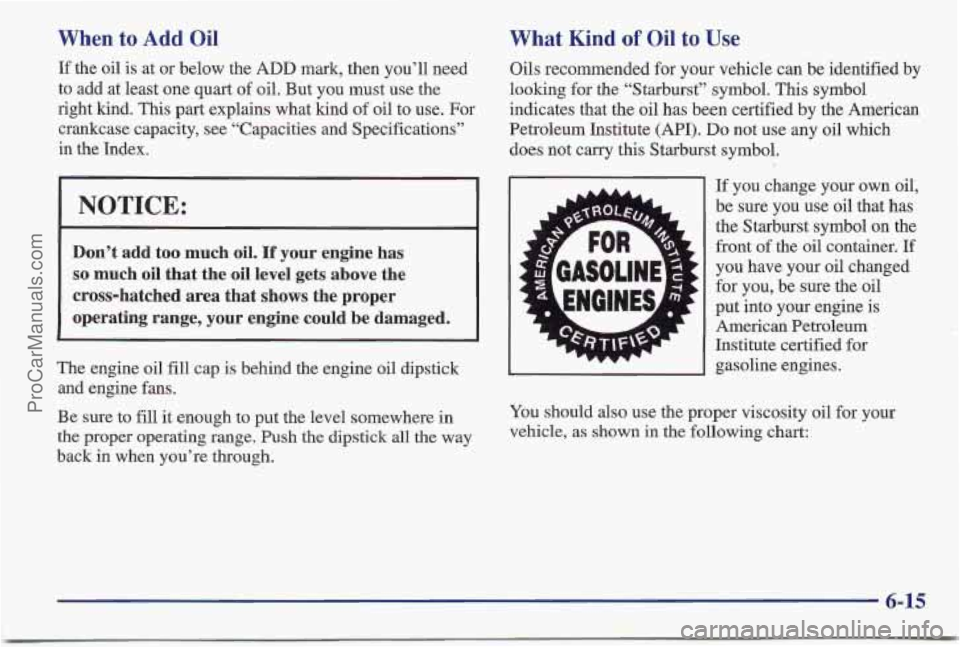
When to Add Oil
If the oil is at or below the ADD mark, then you’ll need
to add at least one quart of oil. But you must use the
right kind. This
part explains what lund of oil to use. For
crankcase capacity, see “Capacities and Specifications”
in the Index.
What Kind of Oil to Use
Oils recommended for your vehicle can be identified by
looking for the “Starburst” symbol. This symbol
indicates that the oil has been certified by the American
Petroleum Institute (API).
Do not use any oil which
does not carry this Starburst symbol.
NOTICE:
Don’t add too much oil. If your engine has
so much oil that the oil level gets above the
cross-hatched area that
shows the proper
operating range, your engine could be damaged.
The engine oil fill cap is behind the engine oil dipstick
and engine fans.
Be sure to
fill it enough to put the level somewhere in
the proper operating range. Push the dipstick all the way
back in when you’re through.
If you change your own oil,
be sure you use oil that has
the Starburst symbol on the
front
of the oil container. If
you have your oil changed
for you, be sure the oil
put into your engine is
American Petroleum
Institute certified for
-_
I I gasoline engines.
You should also use the proper viscosity oil for your
vehicle, as shown in the following chart:
6-15
ProCarManuals.com
Page 269 of 405
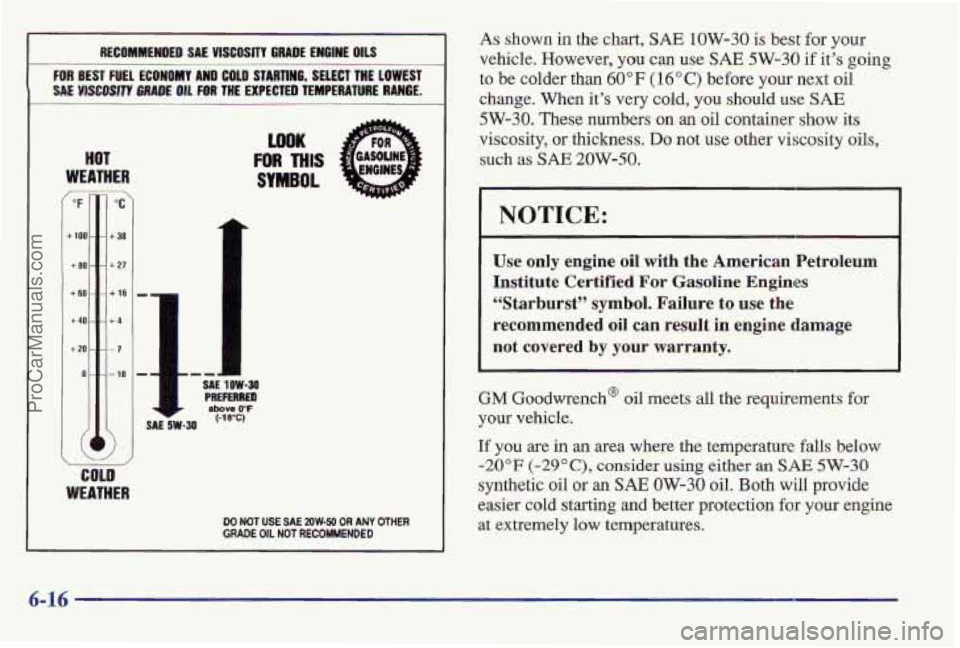
RECOMMENDED SAE VISCOSITY GRADE ENGINE OILS
FOR BEST FUEL ECONOMY AND COLD STIIRTING, SELECT THE LOWEST
SAf YSCDSJTY =DE OIL FOR THE EXPECTED TEMPERATURE RANGE.
HOT
WEATHER I
“F
k 100 -
+ 80 -
+60.
+40-
+ 20.
0.
7 “C
. +30
- +27
- + 16
- +4
--7
- -18
WEATHER
LOOK
FOR THIS
SYMBOL
I - SAE 5W-M -
DQ NOT USE SAE ZOW-50 OR ANY OTHER GRADE OIL NOT RECOMMENDED
As shown in the chart, SAE 1OW-30 is best for your
vehicle. However, you can
use SAE 5W-30 if it’s going
to be colder than 60
OF ( 16 O C) before your next oil
change. When it’s
very cold, you should use SAE
5W-30. These numbers on an oil container show its
viscosity,
or thickness. Do not use other viscosity oils,
such
as SAE 2OW-50.
NOTICE:
Use only ‘engine oil with thle American Petroleum
Institute Certified For Gasoline Engines
“Starburst” symbol. Failure
to use the
recommended oil can result
in engine damage
not covered by your warranty.
GM Goodwrench@ ail meets all the requirements for
your vehicle.
If
you are in an area where the temperature falls below
-20°F (-29”C), consider using either an SAE 5W-30
synthetic oil or an SAE OW-30 oil. Both will provide
easier cold starting
and better protection for your engine
at extremely low temperatures.
6-16
ProCarManuals.com
Page 270 of 405
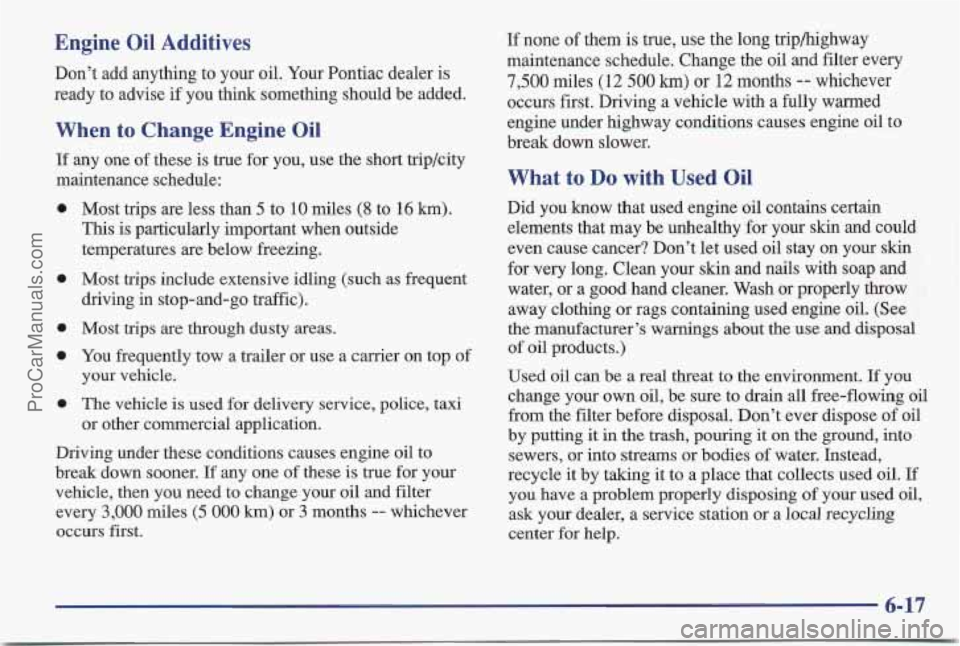
Engine Oil Additives
Don’t add anything to your oil. Your Pontiac dealer is
ready to advise if you think something should be added.
When to Change Engine Oil
If any one of these is true for you, use the short trip/city
maintenance schedule:
Most trips are less than
5 to 10 miles (8 to 16 km).
This is particularly important when outside
temperatures are below freezing.
Most trips include extensive idling (such as frequent
driving in stop-and-go traffic).
Most trips
are through dusty areas.
You frequently tow a trailer or use a carrier on top of
your vehicle.
The vehicle
is used for delivery service, police, taxi
or other commercial application.
Driving under these conditions causes engine oil to
break down sooner.
If any one of these is true for your
vehicle, then you need to change your oil and filter
every
3,000 miles (5 000 km) or 3 months -- whichever
occurs first.
If none of them is true, use the long triphighway
maintenance schedule. Change the oil and filter every
7,500 miles (12 500 km) or 12 months -- whichever
occurs first. Driving a vehicle with a fully warmed
engine under highway conditions causes engine oil to
break down slower.
What to Do with Used Oil
Did you know that used engine oil contains certain
elements that may be unhealthy for your
skin and could
even cause cancer? Don’t let used oil stay on your skin
for very long. Clean your skin and nails with soap and
water, or a
good hand cleaner. Wash or properly throw
away clothing or rags containing used engine oil. (See
the manufacturer’s warnings about the use and disposal
of oil products.)
Used oil can be a real threat to
the environment. If you
change your own oil, be sure to drain all free-flowing oil
from the filter before disposal. Don’t
ever dispose of oil
by putting
it in the trash, pouring it on the ground, into
sewers, or into streams or bodies of water. Instead,
recycle it by taking it to a place that collects used oil. If
you have a problem properly disposing of your used
oil,
ask your dealer, a service station or a local recycling
center for help.
ProCarManuals.com
Page 274 of 405
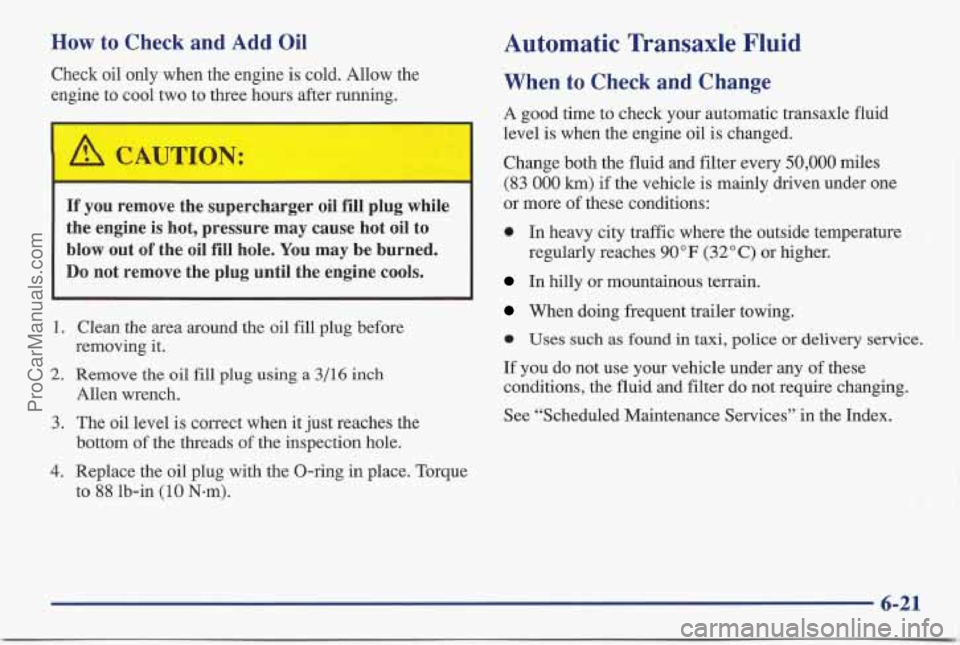
How to Check and Add Oil
Check oil only when the engine is cold. Allow the
engine to cool two to three hours after running.
If you remove the supercharger oil fill plug while
the engine
is hot, pressure may cause hot oil to
blow out
of the oil fill hole. You may be burned.
Do not remove the plug until the engine cools.
1. Clean the area around the oil fill plug before
removing it.
2. Remove the oil fill plug using a 3/16 inch
Allen wrench.
3. The oil level is correct when it just reaches the
bottom
of the threads of the inspection hole.
4. Replace the oil plug with the O-ring in place. Torque
to
88 lb-in (10 N-m).
Automatic Transaxle Fluid
When to Check and Change
A good time to check your autamatic transaxle fluid
level is when the engine
oil is changed.
Change both the fluid and filter every
50,000 miles
(83 000 km) if the vehicle is mainly driven under one
or more of these conditions:
0 In heavy city traffic where the outside temperature
regularly reaches
90 OF (32 O C) or higher.
In hilly or mountainous terrain.
When doing frequent trailer towing.
0 Uses such as found in taxi, police or delivery service.
If you do not use your vehicle under any
of these
conditions, the fluid and filter do not require changing.
See “Scheduled Maintenance Services”
in the Index.
6-21
ProCarManuals.com
Page 278 of 405
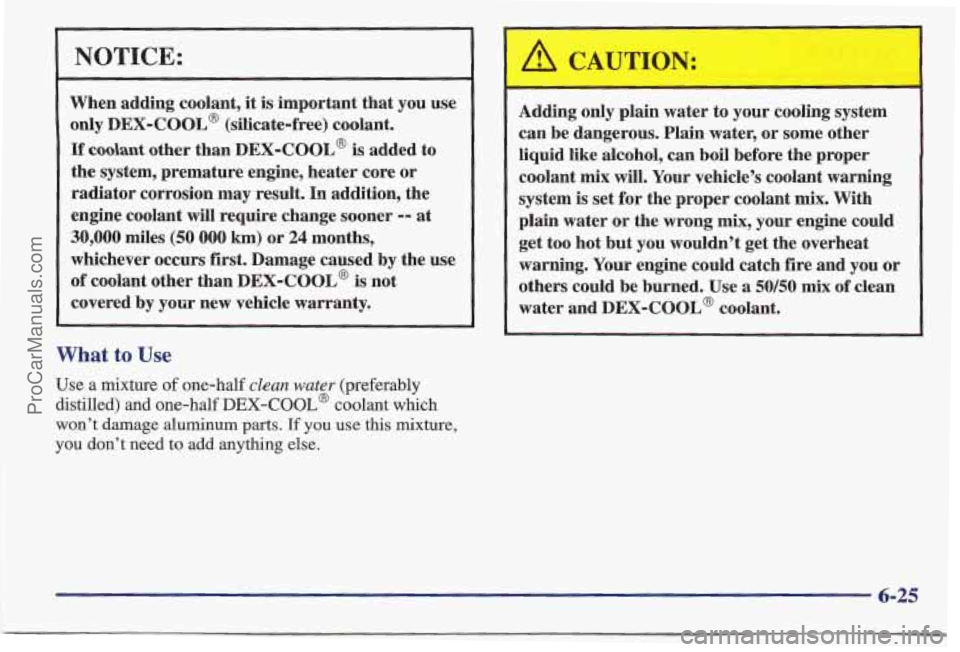
NOTICE:
When adding coolant, it is important that you use
only
DEX-COOL@ (silicate-free) coolant.
If coolant other than DEX-COOL@ is added to
the system, premature engine, heater core or
radiator corrosion may result.
In addition, the
engine coolant will require change sooner
-- at
30,000 miles (50 000 km) or 24 months,
whichever occurs first. Damage caused by the use
of coolant other than DEX-COOL@ is not
covered by your new vehicle warranty. Adding
only plain water to your cooling system
can be dangerous. Plain water, or some other
liquid like alcohol, can boil before the proper
coolant mix will. Your vehicle’s coolant warning
system is set for the proper coolant mix. With
plain water or the wrong mix, your engine could
get too hot but you wouldn’t get the overheat
warning. Your engine could catch fire and you or
others could be burned. Use a 50/50 mix of clean
water and DEX-COOL@ coolant.
What to Use
Use a mixture of one-half clean water (preferably
distilled) and one-half
DEX-COOL@ coolant which
won’t damage aluminum
parts. If you use this mixture,
you don’t need to add anything else.
6-25
ProCarManuals.com
Page 304 of 405
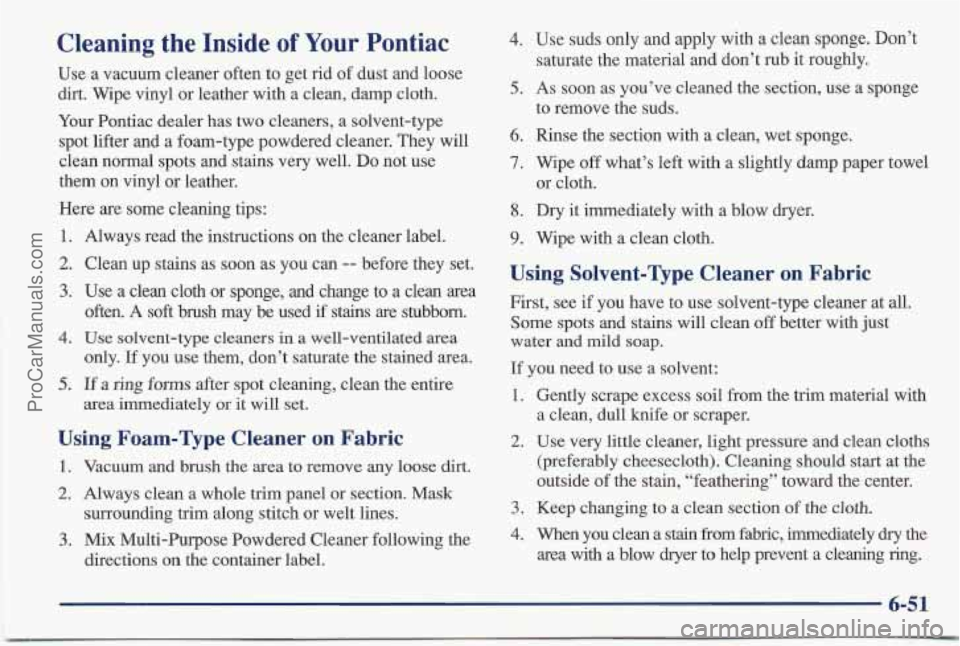
Cleaning the Inside of Your Pontiac
Use a vacuum cleaner often to get rid of dust and loose
dirt. Wipe vinyl or leather with a clean, damp cloth.
Your Pontiac dealer has two cleaners, a solvent-type
spot lifter and a foam-type powdered cleaner. They will clean normal spots and stains very well.
Do not use
them on vinyl
or leather.
Here are some cleaning tips:
1. Always read the instructions on the cleaner label.
2. Clean up stains as soon as you can -- before they set.
3. Use a clean cloth or sponge, and change to a clean area
often.
A soft brush may be used if stains are stubborn.
4. Use solvent-type cleaners in a well-ventilated area
5. If a ring forms after spot cleaning, clean the entire
only. If you
use them, don’t saturate the stained area.
area immediately or
it will set.
Using Foam-Type Cleaner on Fabric
1. Vacuum and brush the area to remove any loose dirt.
2. Always clean a whole trim panel or section. Mask
3. Mix Multi-Purpose Powdered Cleaner following the
surrounding trim along
stitch or welt lines.
directions
on the container label.
4.
5.
6.
7.
8.
9.
Use suds only and apply with a clean sponge. Don’t
saturate the material and don’t rub it roughly.
As soon as you’ve cleaned the section, use a sponge
to remove the suds.
Rinse the section with a clean, wet sponge.
Wipe off what’s left with a slightly damp paper towel
or cloth.
Dry it immediately with a blow dryer.
Wipe with a clean cloth.
Using Solvent-Type Cleaner on Fabric
First, see if you have to use solvent-type cleaner at all.
Some spots and stains will clean off better with just
water
and mild soap.
If you need to use a solvent:
1.
2.
3.
4.
Gently scrape excess soil from the trim material with
a clean, dull knife or scraper.
Use very little cleaner, light pressure and clean cloths
(preferably cheesecloth). Cleaning should start at the
outside of the stain, “feathering” toward the center.
Keep changing to a clean section
of the cloth.
When you clean a stain from fabric, immediately
dry the
area with a blow dryer to help prevent a cleaning ring.
6-51
ProCarManuals.com
Page 319 of 405
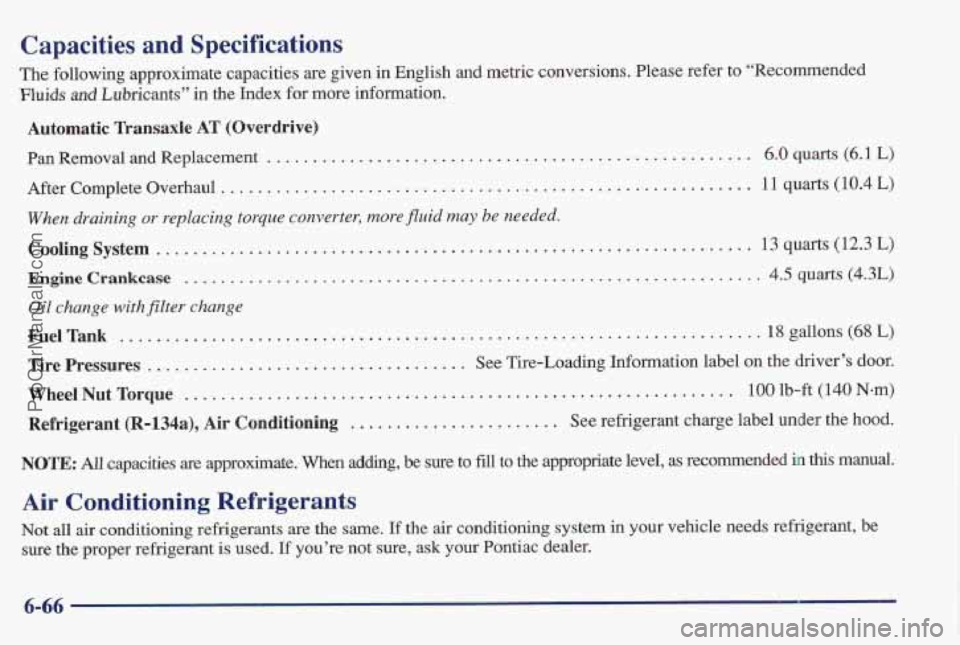
Capacities and Spc Ltions
The following approximate capacities are given in English and metric conversions. Please refer to “Recommended
Fluids and Lubricants’’ in the Index for more information.
Automatic Transaxle AT (Overdrive)
Pan Removal and Replacement ......... ........................................ 6.0 quarts (6.1 L)
After Complete Overhaul .......................................................... 11 quarts (10.4 L)
Cooling System ................................................................. 13 quarts (12.3 L)
Engine Crankcase ............................................................... 4.5 quarts (4.3L)
When draining or replacing torque conver,ter, more fluid may be needed.
.......
Oil change with filter change
FuelTank ........................... ................................ 18 gallons (68 L)
Tire Pressures ................................... See Tire-Loading Information label on the driver’s door.
Refrigerant (R=134a), Air Conditioning ....................... See refrigerant charge label under the hood.
WheelNutTorque ............................................................ 100 lb-ft (140 N-m)
NOTE: All capacities are approximate. When adding, be sure to fill to the appropriate level, as recommended in this manual.
Air Conditioning Refrigerants
Not all air conditioning refrigerants are the same. If the air conditioning system in your vehicle needs refrigerant, be
sure the proper refrigerant is used.
If you’re not sure, ask your Pontiac dealer.
6-66
ProCarManuals.com
Page 325 of 405
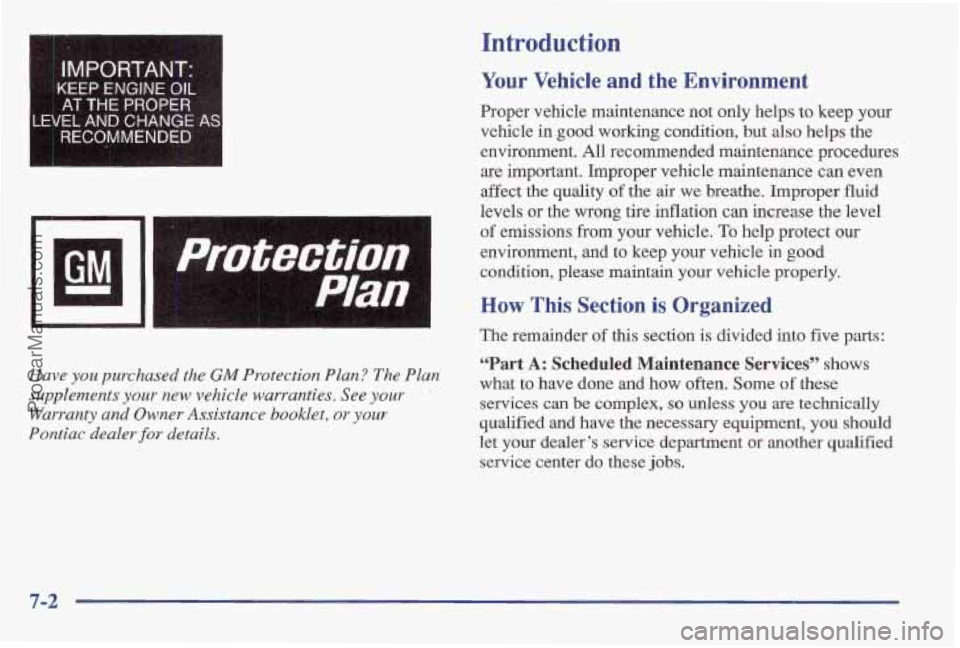
Introduction
IMPORTANT:
,(EEP ENGJNE OIL
AT THE PROPER
LEVEL AND CHANGE AS
RECOMMENDED
Have you purchased the GM Protection Plan? The Plan
supplements your new vehicle warranties. See your
Wurranty and Owner Assistance booklet, or your
Pontiac dealer*for details.
Your Vehicle and the Environment
Proper vehicle maintenance not only helps to keep your
vehicle in
good working condition, but also helps the
environment. All recommended maintenance procedures
are important. Improper vehicle maintenance can even
affect
the quality of the air we breathe. Improper fluid
levels or the wrong tire inflation
can increase the level
of emissions from your vehicle. To help protect our
environment, and to keep your vehicle in good
condition, please maintain
your vehicle properly.
How This Section is Organized
The remainder of thi,s section is divided into five parts:
“Part A: Scheduled Maintenance Services” shows
what to have done and how often. Some of these
services
can be complex, so unless you are technically
qualified and have the necessary equipment,
YOLX should
let your dealer’s service department
or another qualified
service center
do these jobs.
7-2
ProCarManuals.com
Page 328 of 405
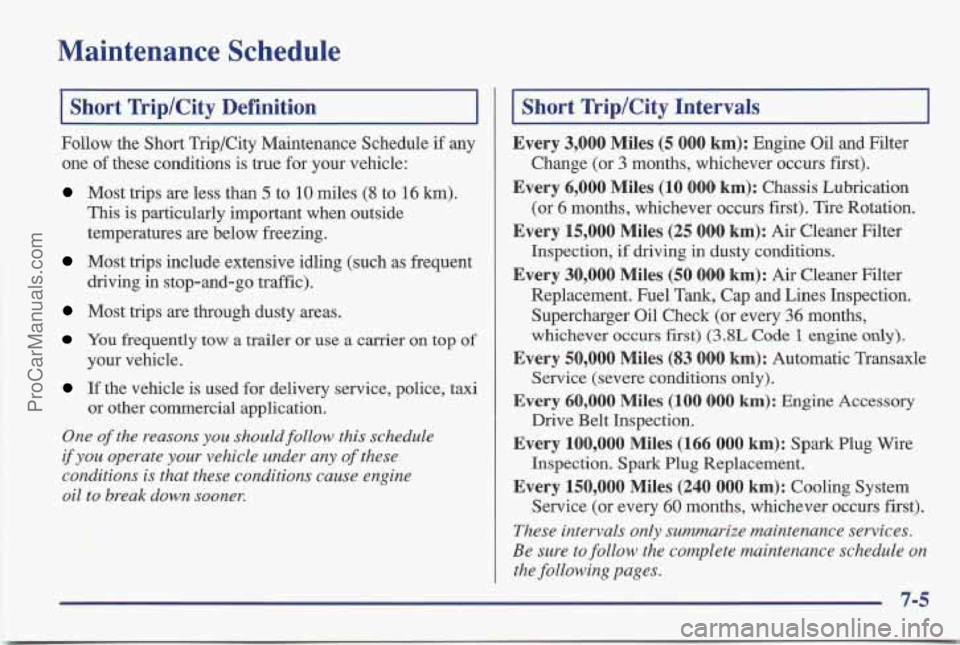
Maintenance Schedule
1 Short Trip/City Definition I
Follow the Short Trip/City Maintenance Schedule if any
one of these conditions is true for your vehicle:
Most trips are less than 5 to 10 miles (8 to 16 km).
This is particularly important when outside
temperatures are below freezing.
Most trips include extensive idling (such as frequent
driving in stop-and-go traffic).
Most trips are through dusty areas.
You frequently tow a trailer or use a carrier on top of
your vehicle.
If the vehicle is used for delivery service, police, taxi
or other commercial application.
One of the reasons you should follow this schedule
if you operate your vehicle under any of these
conditions is that these conditions cause engine
oil to break down sooner.
Short Trip/City Intervals
Every 3,000 Miles (5 000 km): Engine Oil and Filter
Change (or
3 months, whichever occurs first).
Every 6,000 Miles (10 000 km): Chassis Lubrication
(or
6 months, whichever occurs first). Tire Rotation.
Every 15,000 Miles (25 000 km): Air Cleaner Filter
Inspection, if driving in dusty conditions.
Every 30,000 Miles (50 000 km): Air Cleaner Filter
Replacement. Fuel Tank, Cap and Lines Inspection.
Supercharger Oil Check (or every
36 months,
whichever occurs first)
(3.8L Code 1 engine only).
Every 50,000 Miles (83 000 km): Automatic Transaxle
Service (severe conditions only).
Every 60,000 Miles (100 000 km): Engine Accessory
Drive Belt Inspection.
Every 100,000 Miles (166 000 km): Spark Plug Wire
Inspection. Spark Plug Replacement.
Every 150,000 Miles (240 000 km): Cooling System
Service (or every
60 months, whichever occurs first).
These intervals only summarize maintenance services.
Be sure to
follow the complete maintenance schedule on
the following pages.
-- 7-5
ProCarManuals.com
Page 329 of 405
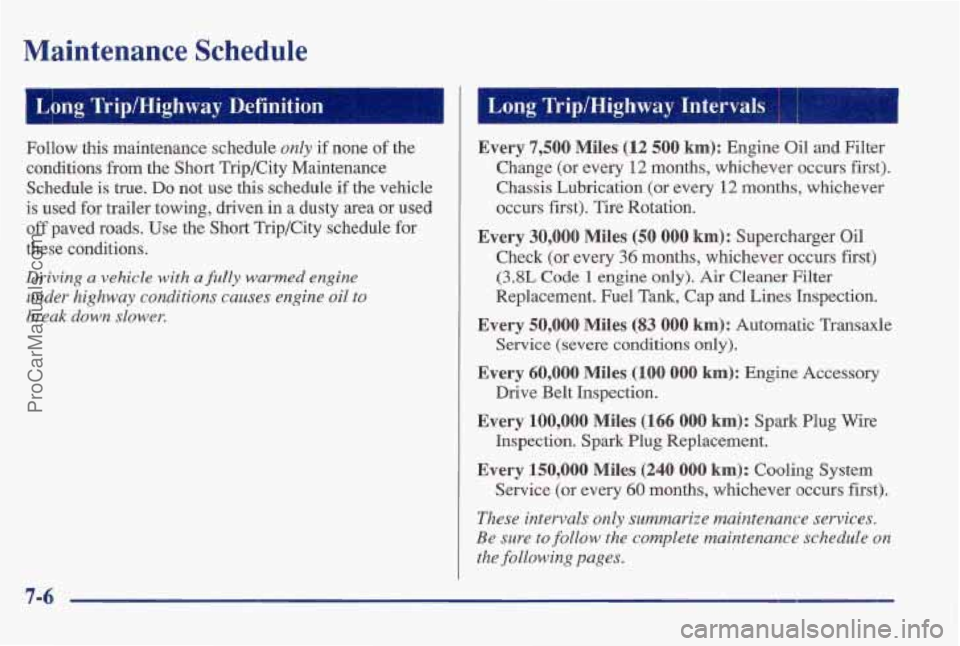
Maintenance Schedule
Follow this maintenance schedule only if none of the
conditions
from the Short Trip/City Maintenance
Schedule is true.
Do not use this schedule if the vehicle
is used for trailer towing, driven in a dusty area or used
off
paved roads. Use the Short Trip/City schedule for
these conditions.
Driving a vehicle with a fdy warmed engine
under highway conditions causes engine
oil to
break down slower.
Every 7,500 Miles (12 500 km): Engine Oil and Filter
Change (or every
12 months, whichever occurs first).
Chassis Lubrication (or every
12 months, whichever
occurs first). Tire Rotation.
Every 30,000 Miles (50 000 km): Supercharger Oil
Check (or every
36 months, whichever occurs first)
(3.8L Code 1 engine only). Air Cleaner Filter
Replacement. Fuel Tank, Cap and Lines Inspection.
Every 50,000 Miles (83 000 km): Automatic Transaxle
Service (severe conditions only).
Every 60,000 Miles (100 0100 km): Engine Accessory
Every 100,000 Miles (166 000 km): Spark Plug Wire
Every 150,0001 Miles (240 000 km): Cooling System
Drive Belt Inspection.
Inspection.
Spark Plug Replacement.
Service (or every
60 months, whichever occurs first).
These intervals only summarize maintenance services.
Be sure
to follow the complete maintenance schedule on
the following
pages.
7-6
ProCarManuals.com